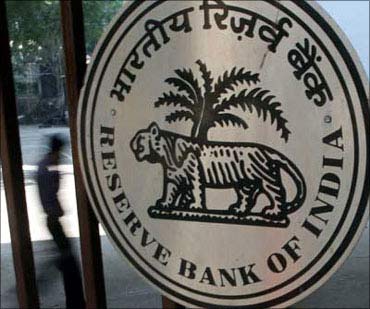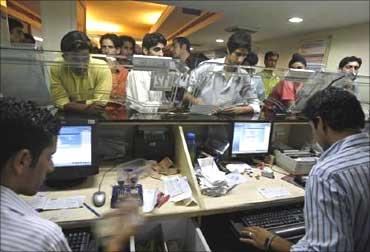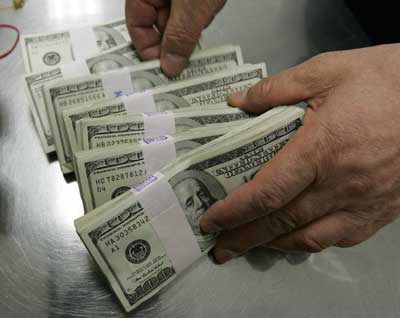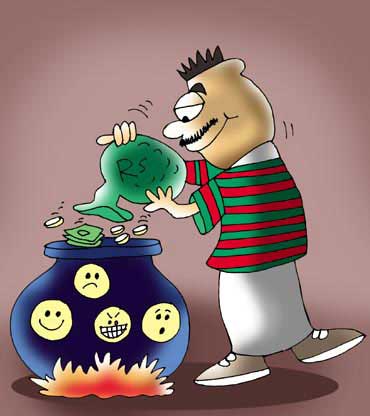 | « Back to article | Print this article |
2010 kept banks busy with working interest, deposit rates
Reserve Bank of India's tight monetary policy brought about constant movement in the lending and deposit rates by banks during the year, a trend that is likely to continue in 2011 due to worrying inflation.

While the loans seekers may have to pay higher equated monthly instalments the depositors can hope for better returns on their savings in the coming year.
The interest rates on home, auto and corporate loans have gone up by about 2 per cent during the course of the year.
The increase in lending rate was matched by a similar increase in interest rate on fixed deposit.
Click NEXT to read further. . .
2010 kept banks busy with working interest, deposit rates
While interest rate on auto and home loans ranges between 8 to 11 per cent, the depositors can earn up to 8-9 per cent.

The hike in retail interest rate during the year was triggered by tightening of the monetary policy by the Reserve Bank of India.
The central bank for the sixth time during the year raised its key short-term lending and borrowing rates known as repo and reverse repo rates to tame inflation.
Close to 10 per cent inflation in February this year prompted Reserve Bank to reverse easy monetary policy by raising cash reserve ratio, the percentage of deposits that banks have to keep with the central bank, by 50 basis points to 5.50 per cent. RBI started tightening key policy rates from February.
Click NEXT to read further. . .
2010 kept banks busy with working interest, deposit rates
As part of the calibrated exit, RBI increased its repo rate by 150 basis points, reverse repo by 200 basis points and cash reserve ratio by 100 basis points during February-November 2010.

However, banks continued to hold on their rates for almost 6 months despite RBI raising key policy rates and reserve ratio in quick succession to tame inflationary expectations. But interest rates started hardening soon after the first quarterly review of the monetary policy in July in which RBI raised short-term lending rate (repo) to 5.75 per cent and short-term borrowing rate (reverse repo) to 4.50.
Thus, repo went up by 0.25 per cent and reverse repo by 0.50 per cent respectively. Soon after the policy action, HDFC Bank announced increase in interest rates which was followed by others.
Click NEXT to read further. . .
2010 kept banks busy with working interest, deposit rates
In August, many major lenders including State Bank of India, Punjab National Bank, Bank of Baroda, Bank of India, Oriental Bank of Commerce and Canara Bank raised interest rates.

Upward movement in the interest rates still continues as many banks, including State Bank of India have further raised deposit and lending rates during December as well. According to analysts, interest rates would harden further in the coming year as there seems to be mismatch between credit and deposit growth.
Besides, tight liquidity conditions are likely to continue for next 2-3 months. Credit growth as of November was 21 per cent while deposit grew by 15 per cent.
In line with hike in policy rates, several banks increased their Base Rates by 10-100 basis points by December.
As many as 53 banks with a share of 94 per cent in total bank credit have fixed their Base Rates in the range of 7.60-9 per cent.
Click NEXT to read further. . .
2010 kept banks busy with working interest, deposit rates
The base rate is the lowest rate below which banks cannot offer loans. In order to bring in more transparency, the base rate was introduced as a replacement for the benchmark prime lending rate from July 1.

Banks are undertaking the second revision since the introduction of base rate. As per the RBI guideline, banks have to review their base rate every quarter.
"The introduction of base rate was the most salient feature of the year when it comes to banking, as it showed that there is a need for government and RBI to ensure that skewed market share can be levelled.
The step will bring in more and more transparency," Ernst & Young India national leader for global financial services Ashvin Parekh said.
Click NEXT to read further. . .
2010 kept banks busy with working interest, deposit rates
At the same time, the bank provided debt restructuring to aviation sector.
The outstanding debt of aviation sector was estimated at whopping Rs 60,000 crore (Rs 600 billion).

After last year's debt restructuring of realty and retail players, the banks again knocked at the RBI doors for more such actions, especially the huge bad loans to the aviation sector, he said.
Besides interest rates movement and debt recast, the banking sector also witnessed something which was unusual -- bribery for loan scam.
Bank of India and Punjab National Bank and LIC Housing Finance officials were allegedly involved in bribery for loans case.
Even an independent director of Central Bank of India was charged with being part of the whole racket.
Click NEXT to read further. . .
2010 kept banks busy with working interest, deposit rates
Central Bureau of Investigation arrested chief executive officer of LIC Housing Finance and seven others senior bankers in connection with a housing finance racket.

The bank officials allegedly colluded with the firm to sanction large scale corporate loans, overriding mandatory conditions for such approvals along with other irregularities.
This episode happened even when the salary revision of the employees of public sector banks was undertaken during the year.
About 800,000 employees of public sector bank received 17.5 per cent hike in salary after much negotiation between management and staff union.
On consolidation front, two mergers took place during the year. First one was the merger of Bank of Rajasthan with ICICI Bank and the other the merger of the smallest associate bank of country's largest lender with the parent State Bank of India itself.
State Bank of Indore in which SBI had 98 per cent stake had 503 branches, including 437 core banking branches and 66 branches for NRI services. Bank of Rajasthan, ICICI Bank deal was valued at about Rs 3,100 crore (Rs 31 billion) resulting in increase of ICICI Bank branch network to about 2,500 across the country.






